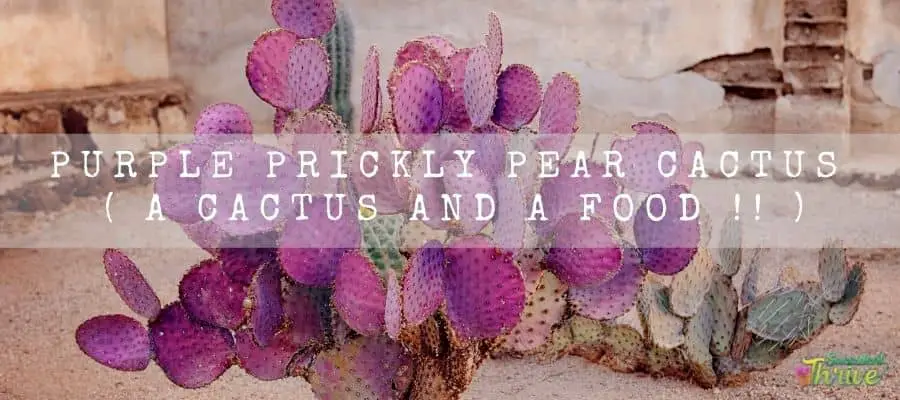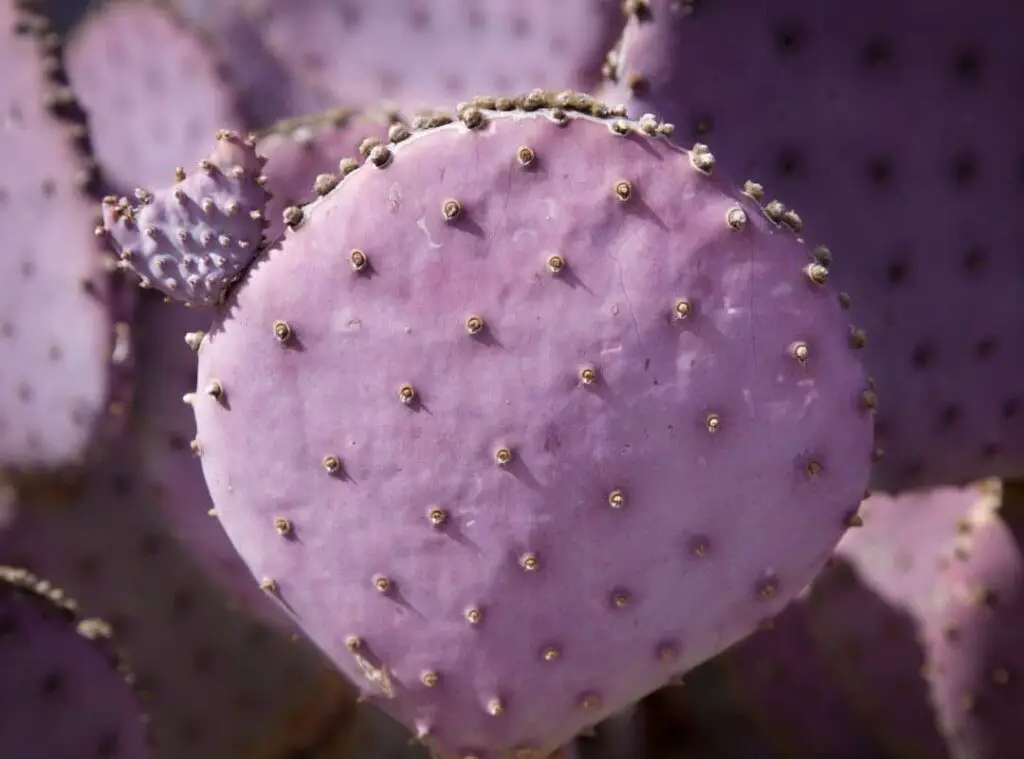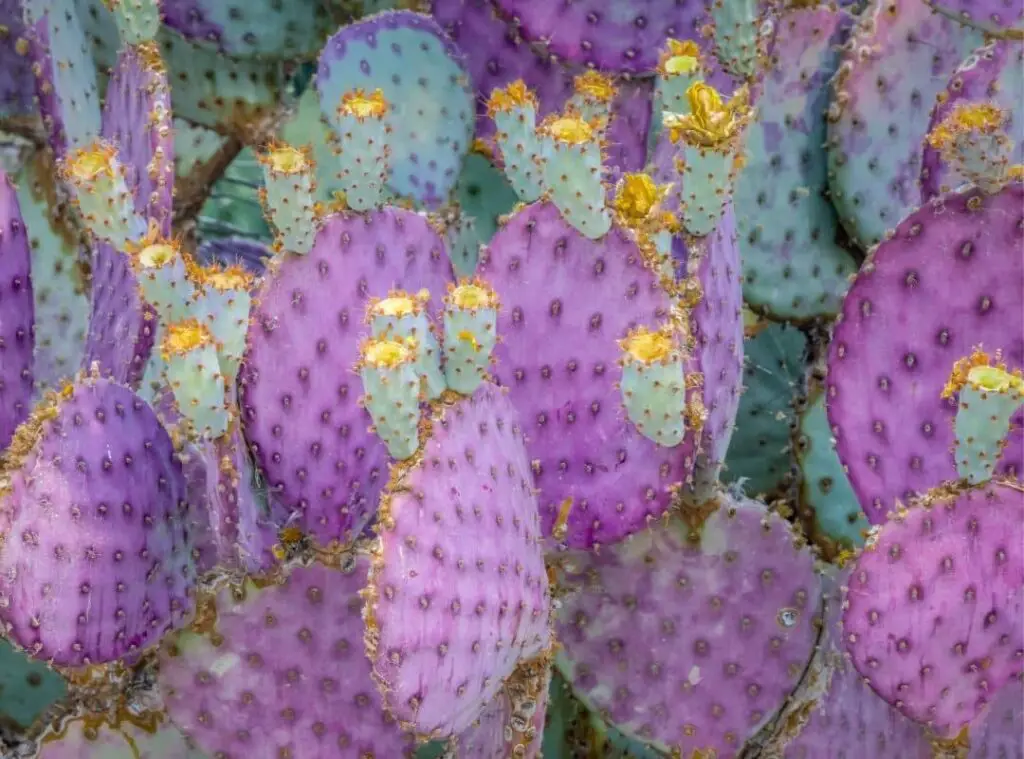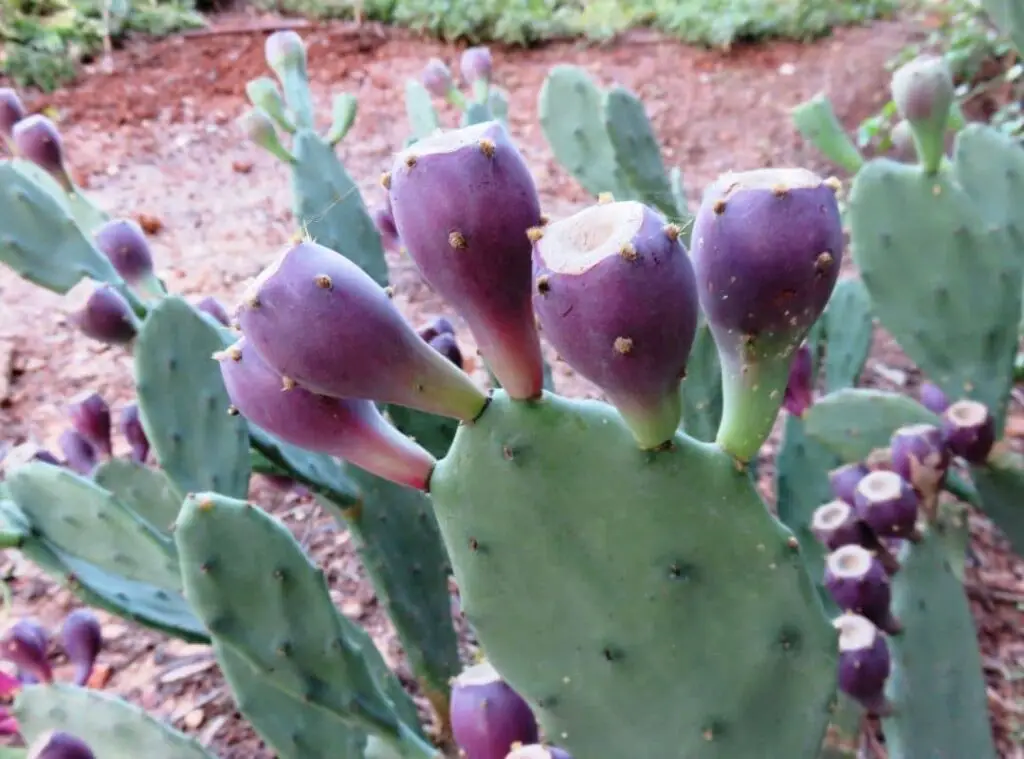Purple Prickly Pear Cactus is a unique looking cactus as it has an intriguing appearance. One of the most interesting facts about the Purple Prickly Pear Cactus’s edible fruit.
This fruit is quite famous in Mexico, Morocco and in southwestern United States as well. You could enjoy their fruit as a candy, jam, jellies or even as snacks.
Purple Prickly Pear Cactus are slow growers. Further, it will take about three to four years to form fruits.
This is regarded as the best prickly pear cactus out of all other prickly pear cactus due to the vibrant foliage colors they have.
Purple Prickly Pear Cactus’ scientific name is Opuntia macrocentra. So, if you are excited to discover more about these plants, it would be worth reading this article.

How do I identify Purple Prickly Pear Cactus?
As aforesaid these are clump forming sets of cacti. In terms of the sizes, they would reach a maximum height of 4 feet and 5 feet in width.
One might think they look like a shrub type too. When there are cool dry winter months, the large leaf pads would develop a purple tinge.
Further you could spot the tan spines covering the pads of these plants.
Besides, they produce flowers and they will be yellow in color. Their flowering season would be late spring.
You could spot the Purple Prickly Pear Cactus pads in blue gray in color during summer. Apart from these, Purple Prickly Pear Cactus produce a fruit type which is about 3 inches in diameter. The colors of the purple prickly pear cactus fruit would be red or purple.
Size of the plant
Purple Prickly Pear Cactus would reach a maximum height of 4 feet. Further they could be about 5 feet in width when they grow to their fullest potential.
Growth rate
Purple Prickly Pear Cactus are a slow growing set of plants.
One look care guide
| Botanical Name | Opuntia macrocentra |
| Common Name | Purple Prickly Pear Cactus , |
| Plant Type | Cactus |
| Mature Size | Maximum height 4 feet / About 5 feet in width |
| Sun Exposure | Full sunlight |
| Soil Type | Well-draining, sandy |
| Soil pH | pH level of 6.0-7.5 |
| Bloom Time | late spring |
| Flower Color | Yellow |
| Hardiness Zones | USDA hardiness zone 4 |
| Native Area | Sonoran Desert |
| Toxicity | Nontoxic |
| Average price | 8 USD |
How do you take care of Purple Prickly Pear Cactus?
Light Requirement
Purple Prickly Pear Cactus prefer to have full sunlight for them to grow well. Ideally full sunlight for about 8 hours would be optimal for their vigorous growth.
Having said that they can tolerate the partial shade also given that you have grown them in a hotter climate like in a desert.
If you expose them for proper sunlight levels, it will guarantee that you will have more beautiful blooms.
Temperature and humidity
Purple Prickly Pear Cactus fond of having warmer temperatures. Having said that, they can tolerate cold to some extent as well.
However, they will do much better if you grow them exposed to warmer temperatures. The minimum temperature Purple Prickly Pear Cactus can withstand is 45 degrees Fahrenheit.

Is it cold hardy?
USDA Hardiness Zone
Purple Prickly Pear Cactus can perform well in USDA hardiness zones 4.
Watering Requirement
Further when watering, ensure that you do not make the soil soaked. Instead make it moistened. Consider that you are not pretty sure whether they need water or not.
Then in that circumstance , you need to skip watering them for a couple of days and then water the cactus.
Generally, you can water them once every two to four weeks. That will ensure a strong root system is formed.
Soil Requirement Type / pH
A well-draining soil mixture is a must to grow the Purple Prickly Pear Cactus. Ideally it needs to be dry, sandy, or gravely.
Having said that you can grow them in a clay soil mixture also.However the most important thing you should assure is that they have an excellent draining feature.
They can thrive in a neutral to acidic mixture where there will be a pH level of 6.0-7.5. If you grow them in a clay soil in a cool region, it will be an issue for the Purple Prickly Pear Cactus.
Pot size Potting and Repotting
You can grow them in pots which are slightly larger than the larger pad. You can grow them in the same pot for a couple of seasons.
However, when they become root bound you could either repot them or grow them outdoors. However, when you select a pot, it needs to have sufficient draining holes. To better the drainage you can provide a gravel layer at the pot base.
When you repot, it will encourage the new growth of the plants. When you grow them in the same pot for too long, it will not be optimal for the plant’s growth.
However, before repotting, ensure that their soil is dry. Next you can gently remove the cactus whilst holding it gently from its base. Next remove the old soil around the plants.
If you had done any damage to the plants unknowingly, you can treat those with fungicides. Next plant them in a new container filled with a well-draining soil mix.
You do not have to water the recently repotted Purple Prickly Pear Cactus. Instead let them establish and next start watering them.
Further, always keep in mind that you need to wear thick gardening gloves and long-sleeved shirts so that the plants will not harm you.
Where to Plant
You can plant them outdoors as well as indoors. With that being said, when you grow them outdoors, you need to plant them in a spot where they will be away from the walking pathways.
Unless chances are that their spines could harm the passersby. Besides, you can grow them in rock gardens too.
As long as you provide full sunlight and a well-draining soil mix, Purple Prickly Pear Cactus can thrive well.

Fertilizer and time of year
Purple Prickly Pear Cactus are not very demanding in terms of the fertilizer requirements.
However, it would be beneficial if you have grown them in a poor-quality soil medium which is not enriched with nutrients.
If you have grown them in garden soil, you can neglect feeding them. Having said that, when you grow them indoors, a little bit of feeding would be beneficial for the plant’s vigorous growth.
You can proceed with a well-balanced fertilizer when feeding the Purple Prickly Pear Cactus. If you do not feed them well, chances are that they might show stunt growth or look unhealthy.
Dormancy
Once the spring comes, they will look fresh. However, if there are any deformed growth, you can remove those.
Toxicity
Purple Prickly Pear Cactus are not toxic in general
Common bugs and illnesses
Purple Prickly Pear Cactus are prone to insect’s attacks. Insects such as leaf footed bugs are quite attractive towards these plants.
You could call these insects as sucking insects also. The reason behind this common name is that they use their mouth organs to suck the sap from the plants.
The saliva they release, and their feeding activity are unhealthy for the Purple Prickly Pear Cactus, Further chances are that it could even damage their tissues as well.
Chelinidea vittiger is a commonly spotted bug type which could harm these precious plants.
You can use insecticidal soap and horticultural oil to remedy these bugs. However, you could do this only if they are in the nymph stage though.
Unless, getting rid of them when they are mature would be very challenging. Besides, using systemic insecticides is not the best you could do to overcome them as they are not very effective in overcoming this problem. Further when applying them, you need to be extra cautious.
In addition to these, cochineal scale can also be troublesome for the Purple Prickly Pear Cactus. These are small insect types, and they will suck the sap from the Purple Prickly Pear Cactus.
A cochineal scale female version can even disfigure these cacti as they produce a waxy secretion.
If the cochineal scale spread on a severe scale, chances are that it could even kill the Purple Prickly Pear Cactus. If they have spread on a minor level, you can simply wash them away from the plants with water.
Moreover, cactus borers can also infest the Purple Prickly Pear Cactus. These are also called cactus longhorn beetles.
They have inherited this name due to the fact their larvae reach the Purple Prickly Pear Cactus flesh and keep consuming them.
Besides, sunscald is a fungal disease which you may come across when growing the Purple Prickly Pear Cactus.
This is also known as scorch. This is one of the diseases which could be quite harmful for the plants. At the start, you could spot this disease in isolated spots.
However, once the disease spread further, you could see how the cactus pad turned into red. Ultimately , it could even kill your beloved Purple Prickly Pear Cactus.
Besides, Purple Prickly Pear Cactus may come across another fungal disease called charcoal spot and it could also create greater damage for the plants.
Unfortunately, there are no remedies for this condition. Last but not least root rot is the other disease which could be troublesome for the Purple Prickly Pear Cactus.
If you grow the cactus in a soggy potting medium and if you supply water in excess, it will pave the way for root rot. I suggest you sterilize the soil before you use them so that you will not come across these issues.
Special Care tips
Purple Prickly Pear Cactus do not require you to prune them. However , if you spot any unhealthy pads, you can remove them.

How to propagate Purple Prickly Pear Cactus
By using the cuttings
If you want to practice a common way of propagating the Purple Prickly Pear Cactus, you could use the cuttings and do it.
That is simply because you could use cuttings to propagate many species of the cacti. So, to do that, you need to take a pair of scissors which you have sterilized and cut a few pads from the mother Purple Prickly Pear Cactus.
Alternatively you may use sterilized shears also for this purpose. Make the cuttings closer to the nods. Do not slice the pads in half also. Next leave the cuttings in a place where they can develop callous.
When they have finished developing calluses, you can place the cut side of the pad in the pot which you have filled with dry soil. Refrain watering them until they produce new growth.
By using the seeds
You can simply sow the seeds to propagate the Purple Prickly Pear Cactus. However, before you do that you need to sacrifice them while using an abrasive stone.
That will help to damage the caulk layer. Next you need to soak the seeds in distilled water. Soak them in water for about 24 hours.
After that place them in a Ziplock bag. Ensure that you provide the recommended care conditions for them during this process.
Usually, the germination of the seeds takes place unevenly. You can plant the sprouted seeds in a soil mixture.
Propagate In water
You can propagate the Purple Pear Cactus in water.
Having said that , there could be some issues when propagating them in water as it could create different kinds of roots when you propagate them in water, further the lack of nutrients that water has is also an issue. Hence the easiest way would be propagating them in soil.
Purple Prickly Pear Cactus benefits
Purple Prickly Pear Cactus has fiber and antioxidant content and so many other ingredients That is what is crucial for the majority of the benefits they have.
1. Weight loss
Weight loss will be aided by the fiber in the Purple Prickly Pear Cactus. That increases the excretion and reduces the energy absorption.
Several studies have emphasized this factor using adults who have taken tablets containing the cactus fiber.
The results of the studies have shown that it has resulted in more facial fat excretion. The Purple Prickly Pear Cactus fiber could be very useful here as aforesaid.
They in fact minimize the dietary fat which you have to absorb. Purple Prickly Pear Cactus fruit have fiber more than three grams and they have a low calorie count as well.
2. Skin and hair
There are people who consume Purple Prickly Pear Cactus as a way to glow the skin and to make your hair shiny.
Some of the Purple Prickly Pear Cactus are added for hair conditioners and for skin care products. They contain elements such as vitamin c, betalain pigments.
They have anti-inflammatory and antioxidant effects. Further Purple Prickly Pear Cactus include polyunsaturated fatty acids, especially in the Purple Prickly Pear Cactus seeds and peel.
They are also crucial for glowing skin and for hair health. Purple Prickly Pear Cactus antioxidant boost is useful for skin care and for hair health.
It could protect them from the oxidative stress which you may suffer from aging, inflammation and sun exposure.
Using Purple Prickly Pear Cactus for skin care is regarded as a luxury organic way of treating your skin.
Berber women have used the Purple Prickly Pear Cactus oil for so long to have flawless skin especially after they expose for sunlight and for heat.

3. Diabetes
Purple Prickly Pear Cactus are useful for blood sugar management. Further it could avoid diabetes complications also.
Purple Prickly Pear Cactus have a soluble fiber pectin and that have blood sugar lowering properties.
There are preliminary level studies which are conducted to show that it could decrease the fasting blood sugar as well as the post meal insulin levels.
In fact, you could expect it to happen among healthy adults and among the people who have type 2 diabetes.
However, when it comes to heart health, the Purple Prickly Pear Cactus fruits would be more crucial than the Purple Prickly Pear Cactus pads.
The people who are suffering from type 2 diabetes have a high component of triglyceride and bad cholesterol levels.
Hence, they will have a greater opportunity to have heart diseases. As such if you consume Purple Prickly Pear Cactus fruits, it will reduce the unhealthy cholesterol levels. However, I believe there should be more research to study this factor further.
4. Liver health
In ancient times, many people used Purple Prickly Pear Cactus to treat liver problems. Further there are some studies which have been conducted recently and it is proven correct.
Purple Prickly Pear Cactus have antioxidant compounds as aforesaid. They are helpful to protect your livers also from the repercussions it may have from oxidative stress.
Some have conducted studies to emphasize this factor using rats. Further , it is said that Purple Prickly Pear Cactus juice could help to overcome the injuries caused by chronic alcoholic consumption.
They do that by enhancing the antioxidant status and by preventing the oxidative damage which is caused by alcohol.
Further there are studies to show that it could even reduce the hangover symptoms if you use the extract of the Purple Prickly Pear Cactus. Having said that, there should be more research to emphasize on these factors.
5. As a food source
Some Moroccans have made it a habit to eat the Purple Prickly Pear Cactus. You could spot the street vendors selling the Purple Prickly Pear Cactus during seasons like in July.
They usually peel and sell them. You could spot some eating them at the streets itself while there will be some people who might bring them home and consume.
There are jams, spreads also made from the Purple Prickly Pear Cactus pulp. However, I suggest you eat them in moderation so that it will be delicious.
However, if you eat them in big numbers, chances are that you may suffer from constipation. Further you could use Purple Prickly Pear Cactus to produce certain pharmaceutical products and remedies.
The reason to use them for these purposes is that they have high components of vitamin E, vitamin A and Vitamin C . Additionally, they contain omega 6 and magnesium as well.
6. The Prickly Pear Feeds Livestock
Purple Prickly Pear Cactus leaves inside are used to fulfill the dietary requirements of the animals who live in dry areas.
So, feeding them with Purple Prickly Pear Cactus is cheap and easy as it is difficult to find the other plants and the nutrients to feed the animals in such conditions.
Purple Prickly Pear Cactus do have a higher component in protein. Instead, they can hydrate them highly. This is very useful for livestock as if they suffer from dehydration in arid conditions chances are that it could even kill them.
Purple Prickly Pear Cactus Industry Empowers Women.
Many Moroccan women are extracting the seeds from the fruits of Purple Prickly Pear Cactus and use them for their business purposes.
This is very common among the poor ladies of Morocco as they can earn money by selling them. Hence selling Purple Prickly Pear Cactus would be beneficial for them financially. It is really helpful for the hard working females in Morocco.
Conclusion
To wind up, trust I have covered all important things on Purple Prickly Pear Cactus , starting from how you grow them, how you should propagate them to the benefits they have.
It is evident that Purple Prickly Pear Cactus are such great and worth plants to have.
You need to start growing them more and more and educate your friends also in this regard and urge them also to grow these precious plants.
Read Next : Titanopsis Hugo Schlechteri | Beautiful Out Of The World Succulent | Titanopsis Schwantesii | Wonderful White Jewel Cactus | Titanopsis Primosii | Amazing Stone-Shaped Succulent |
